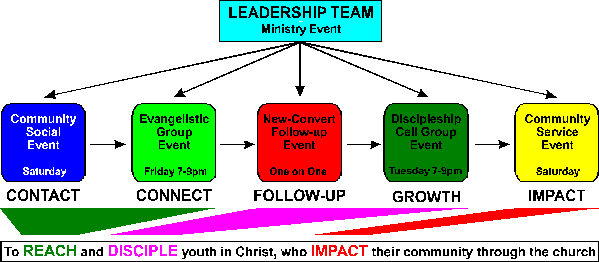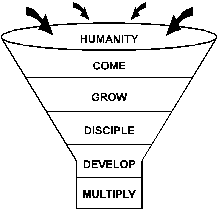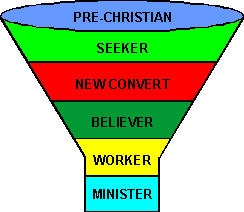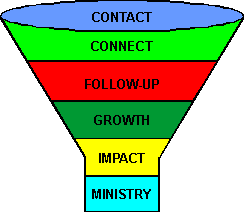
Youth ministry can be frustrating! Youth leaders live with guilt because they do not see new converts in the group; many groups have no contact with unchurched youth in their area, except the occasional young person who wanders though the door; some groups struggle to integrate newcomers who come for the fun but do not return the following week; tension exists between those who consider the programmes too worldly and those who consider them too spiritual.
Working as a youth ministry consultant in a newly established church in Windsor, South Africa,
the youth leaders and I began to develop and implement a model of youth ministry that was
extensive in scope (reaching and discipling youth) and intensive in depth (caring for and developing youth and leaders). The model ensures that new comers are added to the group, and
that those already within the group are matured in their faith and equipped to serve. It starts with
a Contact Event aimed at reaching unchurched youth on their turf by making contact and
establishing a relationship with them. They are invited to a Connect Event where the seeking young person connects with other Christians and with God through faith in Jesus Christ. The next stage is for the new convert to
attend a Follow-up Event where they are grounded in the faith. They then attend a Growth Event designed to help them grow to spiritual maturity. The next stage is an Impact Event where growing youth can reach out and impact their community for Christ. Finally, those mature Christian youth are developed into futher areas of ministry through the Ministry Event. The model is shown diagrammatically below:

The following flow chart shows the movement of youth through the process:

The following animated image shows the movement of youth through the commitment levels:

Reflecting on the problem and our solution, we concluded that frustrations arise in youth ministry due to the lack of a suitable youth ministry model. They may also be due to a focus on individual events rather than on youth ministry as a process or a journey. If leaders would look past individual activities, programmes and events, and design a model of youth ministry that is comprehensive in its scope and application, it is highly likely that many frustrations connected with youth ministry would be removed. Matthew 28:18-20 speaks of the journey of ministry:
Then Jesus came to them and said, "All authority in heaven and on earth has been given to me. Therefore go and make disciples of all nations, baptizing them in the name of the Father and of the Son and of the Holy Spirit, and teaching them to obey everything I have commanded you. And surely I am with you always, to the very end of the age."
A close reading of this passage shows that the main verb is: make disciples. This is the purpose of youth ministry: to make disciples of youth. Making disciples is a process with three stages - identified by the three participles in the passage: going, baptizing and teaching. The discipleship journey involves making contact and building relationship with people (going); sharing the gospel with them (baptizing - as part of the conversion-initiation experience) and then nurturing them in the faith (teaching).
The model of ministry that we implemented at Windsor Fellowship has been based on a model of youth ministry that has been around for many years. Duffy Robbins, in Youth Ministry That Works, presents a youth ministry model that identifies youth at different levels of spiritual commitment (seen in the following diagram):
|
|
|
|
|
|
|
|
|
|
|
1. Humanity Level
Youth who are within the geographical sphere of influence of the group, yet who are not influenced by the group at present and who may not even know that the group exists. Making contact with these youth involves meeting them on their turf or reaching them through the members of the youth group who are at school with them.
2. Come Level
Youth who attend when the group is doing something they like, usually something they consider fun or entertaining. They make no pretence of commitment to Christ and simply want to have a good time. Leaders must see the potential of reaching these youth with the gospel.
3. Grow Level
Youth within the group who are willing to submit themselves to spiritual growth. These are youth who take part in an event, even if it involves some amount of spiritual input. It must be realised that willingness to submit to growth is not the same as commitment to growth - youth at this level are not seeking spiritual growth on their own initiative.
4. Disciple Level
Youth who take initiative for their own spiritual growth and discipline themselves to grow through disciplines such as the study of Scripture, prayer and witnessing. As they begin to pro-actively participate in their faith development they need instruction and tools to help them grow.
5. Develop Level
Youth willing to take the initiative for the spiritual growth of others as well as themselves. They are ready to develop their leadership skills and minister to their peers, and should be motivated, equipped and mobilised to reach out to youth inside and outside the group. At this level the involvement of adults in ministry among youth is stressed.
6. Multiply Level
Youth willing to reproduce this process in the lives of their friends. These are youth who are ready to assume responsibility for an area of ministry within the youth group.
When the pyramid is turned on its head, it becomes a funnel, where the entry level events provide easy access to the group, and more commitment and participation is required of youth as they go deeper into the funnel.

In order for youth ministry programming to be effective there should be programming designed to meet the needs of young people at each level of commitment. Pool of humanity level programmes will be geared at young people who are probably unchurched and have little interest in religion. They must be integrated into the life of the group, develop meaningful relationships with Christians and hear about God's plan of salvation. There also needs to be programmes that will help young people at the come, grow, disciple, develop and multiply levels.
Many youth groups choose one emphasis for ministry among youth, such as evangelism or education. Merton P. Strommen says in Five Cries of Youth published in 1974, “The cries which underlie the self-reports of 7,050 representative youth challenge the adequacy of a youth ministry that is all evangelism, all social involvement, all socializing activities, or all doctrinal instruction. They posit five basic needs or value-orientations, requiring five distinct accents in a youth ministry.” (preface, page xvi). Read more about the Five Cries and the ministry emphases they suggest.
The commitment level model stresses the need to target ministry at all levels of spiritual growth - so evangelism, social interaction, basic follow-up, discipleship, social action and leadership development are all targeted.
The youth group at Windsor began to evaluate their ministry among youth in the light of commitment level ministry and began to add ministries that targeted six commitment levels.
The following funnel shows the commitment levels that are targeted:

The following funnel shows the ministries targeted at each commitment level:

The six levels and the events are explained more fully as follows:
1. Pre-Christian - Contact
We make contact and establish a relationship with unchurched youth on their turf through a Contact Event. These youth are either evangelised and discipled in their own environment or invited to the next level of ministry. The word pre-Christian is used here of youth who have not yet discovered Christ. It could include pre- or post-Christian young people; who could be churched or unchurched. The key emphasis is that they do not attend the youth group and probably would not do so even if invited to an event. See further details of the Contact Strategy.
2. Seeker - Connect
Youth who are willing to visit the group are invited to a Connect Event which are relationship-based programme events aimed at youth who are seeking. They are given an opportunity to be introduced to the group, discover truth about Christ and hear the gospel in a non-threatening environment. See further details of the Connect Strategy.
3. New Convert - Follow-up
The new convert attends a Follow-up Event where they are established in the faith. See further details of the Follow-up Strategy.
4. Believer - Growth
The young Christian attends a Growth Event designed to help them grow spiritually - either a group Bible study or a cell group. See further details of the Growth Strategy.
5. Worker - Impact
The growing Christian is invited to take part in an Impact Event where they can reach out and impact their community for Christ through service projects or missions. See further details of the Impact Strategy.
6. Minister - Ministry
The mature Christian is encouraged to discover and use their spiritual gifts through training at ministry events. See further details of the Ministry Strategy.
Sonlife, an international youth ministry organisation, suggests a commitment level strategy for youth ministry based on the Great Commission (Matthew 28:18-20) and the Great Commandment (Matthew 22:37-39). They stress that the mission is to make disciples - and in fact, to keep working until each disciples reproduce people who are as devoted to following Jesus as they are. The Sonlife approach suggests that each age-based youth ministry will develop ministry in four areas: (1) Winning - intentionally introduce people to Jesus Christ. This is the going part of the Great Commission. (2) Building - help youth continue to grow in a Christward direction. This is the baptising part of the Great Commission. (3) Equipping - equip youth with the life-skills they need to serve God. This is the teaching part of the Great Commission. (4) Multiplying - reach a stage where the ministry continues through shepherds who have been equipped to make disciples. This is the goal of the Great Commission. As we set up an environment in which the Great Commission and Great Commandment are actualised we will balance the components of winning, building and equipping that will ultimately cause multiplication.
Visit the Sonlife website and when possible attend a Sonlife Strategy Seminar.
The Sonlife strategy and the Commitment Level Model of Youth Ministry presented on this page relate as follows:
* Winning covers the Pre-Christian and Seeker levels.
* Building covers the New Convert and the Believer levels
* Equipping covers the Worker level
* Multiplying covers the Minister level
Return to Model of Youth Ministry